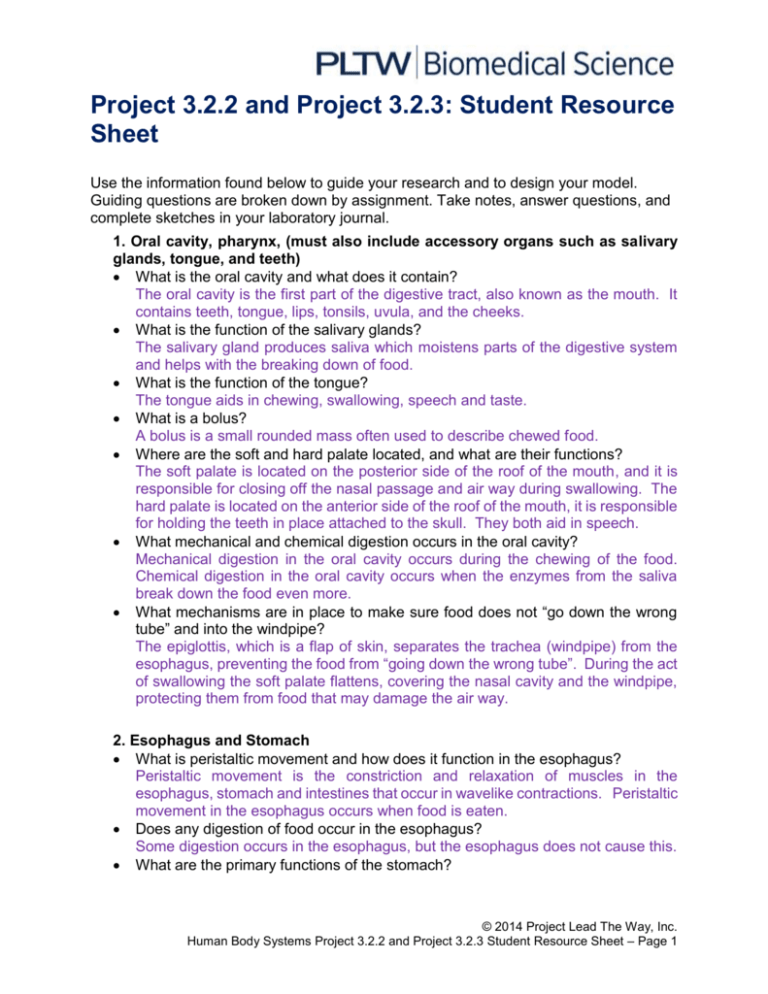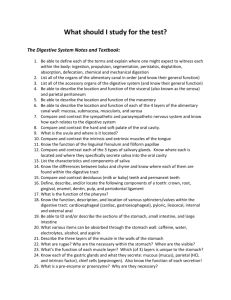Activity 3.2.2 Digestive Design
advertisement

Project 3.2.2 and Project 3.2.3: Student Resource Sheet Use the information found below to guide your research and to design your model. Guiding questions are broken down by assignment. Take notes, answer questions, and complete sketches in your laboratory journal. 1. Oral cavity, pharynx, (must also include accessory organs such as salivary glands, tongue, and teeth) What is the oral cavity and what does it contain? The oral cavity is the first part of the digestive tract, also known as the mouth. It contains teeth, tongue, lips, tonsils, uvula, and the cheeks. What is the function of the salivary glands? The salivary gland produces saliva which moistens parts of the digestive system and helps with the breaking down of food. What is the function of the tongue? The tongue aids in chewing, swallowing, speech and taste. What is a bolus? A bolus is a small rounded mass often used to describe chewed food. Where are the soft and hard palate located, and what are their functions? The soft palate is located on the posterior side of the roof of the mouth, and it is responsible for closing off the nasal passage and air way during swallowing. The hard palate is located on the anterior side of the roof of the mouth, it is responsible for holding the teeth in place attached to the skull. They both aid in speech. What mechanical and chemical digestion occurs in the oral cavity? Mechanical digestion in the oral cavity occurs during the chewing of the food. Chemical digestion in the oral cavity occurs when the enzymes from the saliva break down the food even more. What mechanisms are in place to make sure food does not “go down the wrong tube” and into the windpipe? The epiglottis, which is a flap of skin, separates the trachea (windpipe) from the esophagus, preventing the food from “going down the wrong tube”. During the act of swallowing the soft palate flattens, covering the nasal cavity and the windpipe, protecting them from food that may damage the air way. 2. Esophagus and Stomach What is peristaltic movement and how does it function in the esophagus? Peristaltic movement is the constriction and relaxation of muscles in the esophagus, stomach and intestines that occur in wavelike contractions. Peristaltic movement in the esophagus occurs when food is eaten. Does any digestion of food occur in the esophagus? Some digestion occurs in the esophagus, but the esophagus does not cause this. What are the primary functions of the stomach? © 2014 Project Lead The Way, Inc. Human Body Systems Project 3.2.2 and Project 3.2.3 Student Resource Sheet – Page 1 The main function of the stomach is to break down and digest food in order to extract necessary nutrients from what you have eaten. What is chyme and how does the stomach mix this material? Chyme is a thick semifluid mass of partially digested food and digestive secretions that is formed in the stomach and intestine during digestion. To mix this material gastric glands in the stomach form digestive juices that specifically break down specific molecules in the food. What role does the stomach play in decontaminating the incoming food matter? The stomach releases enzymes that kill bacteria in food and balance pH. The Stomach also breaks down and digest the food. What cells in the stomach function to form enzymes and acids? The parietal cells in the gastric epithelium create HCl. The chief cells create pepsinogen. Why doesn’t gastric juice digest the inside of the stomach? Gastric juice doesn’t digest the inside of the stomach because the inside of the stomach is made of a strong material able to handle gastric juices without being digested itself. What are sphincters and how are they related to the stomach? Sphincters are the openings into and out of the stomach. They open and close when needed to either allow food into the stomach or to allow digested food out of the stomach. What mechanical and chemical digestion occurs in the stomach? Mechanical digestion in the stomach is the churning and contracting of muscles to break down food. Chemical digestion in the stomach occurs when acids and enzymes are released to break down and digest food. 3. Small Intestine and Large Intestine What are the three sections of the small intestine and what role does each section play in digestion or absorption? The three sections of the small intestine are the duodenum, jejunum, and ileum. The duodenum receives partly-digested food, acid, and bile. The jejunum and ileum break down food fully. What is the pH within the small intestine and how is this pH maintained? Within the small intestine the pH is 6, and it is maintained through bicarbonate ions. Where do bile and pancreatic enzymes enter the small intestine? Bile and pancreatic enzymes enter the small intestine through the duodenum. How does food move through the intestines? Food enters through the duodenum, then travels to the jejunum, where it then goes to the ileum, then to the cecum, which then goes to the colon, and then into the rectum. What enzymes act inside the small intestine and what are the functions of these enzymes? Enzymes that act inside the small intestine are amylase, protease, and lipase. Amylase breaks down starch into small carbohydrate molecules. Protease breaks down proteins into amino acids. Lipase breaks down dietary fats into fatty acids and glycerol. What is the function of the large intestine in relation to digestion? © 2014 Project Lead The Way, Inc. Human Body Systems Project 3.2.2 and Project 3.2.3 Student Resource Sheet – Page 2 In digestion the function of the large intestine is to absorb water from the remaining indigestible food, and get rid of the waste material from the body. What are the three sections of the large intestine and what roles does each play in digestion or absorption? The three sections of the large intestine are the cecum, colon, and rectum. The cecum takes digested liquid from the ileum and passes it on to the colon. The colon is where water and salts (when needed) are reabsorbed. The rectum is where leftover waste sits until it is ready to be emptied through the anus. How does the large intestine help maintain a water balance in the body? The large intestine helps the body digest and remove water from the remains of food (feces) after which it will go through the rectum. 4. Pancreas, Liver and Gallbladder What are the size and the location of the pancreas? The pancreas is about 6 inches long. It is across the back of the abdomen, behind the stomach. The head of the pancreas is on the right side of the abdomen and is connected to the duodenum (the first section of the small intestine) through a small tube called the pancreatic duct. What are the different functions of the pancreas, and how is the pancreas directly related to digestion? The pancreas functions as an endocrine gland by releasing juices directly into the bloodstream, and as an exocrine gland by releasing juices through ducts. The pancreas is related to digestion because enzymes that it secretes are sent to the small intestine to break down the food even further. How does the pancreas connect to the rest of the digestive system? The pancreas lies behind the stomach and is connected to the first part of the small intestine called the duodenum. What enzymes are produced by the pancreas and what are their functions? The pancreas produces pancreatic proteases, pancreatic amylase, and pancreatic lipase. Pancreatic proteases, such as trypsin, help digest proteins. Pancreatic amylase helps digest carbohydrates. Pancreatic lipase helps digest fat. How is insulin related to the digestive system? When food is broken down glucose is released into the bloodstream, and if glucose levels become too high insulin is released. What is the size of the liver and where is it located? The average liver weighs around three pounds and is seven centimeters long. The liver is located above the stomach and beneath the diaphragm, mostly in the upper right portion of the abdomen. How does the liver function in relation to digestion? In the digestive system the liver functions to process the nutrients absorbed by the small intestine. The liver also secretes bile into the small intestine to aid in digestion. What are other functions of the liver in the body? Other functions of the liver in the body includes secreting hormones, detoxifying blood, storing simple sugars, production of bile, destroying old red blood cells, and converting stored sugar into useable sugar. What is the relationship between the liver and the gallbladder? © 2014 Project Lead The Way, Inc. Human Body Systems Project 3.2.2 and Project 3.2.3 Student Resource Sheet – Page 3 The gallbladder is underneath the liver, and it also stores and concentrates bile from the liver when it is not in use. What is the function of bile and where does it enter the digestive tract? Bile aids in the digestion of lipids, and enters the digestive tract through the gallbladder/small intestine. © 2014 Project Lead The Way, Inc. Human Body Systems Project 3.2.2 and Project 3.2.3 Student Resource Sheet – Page 4








